When understanding what a high THCA percentage is and its significance in the user experience it can mean the difference between a great experience and a horrible one.
We often come across THCA flower or products boasting higher THC-A levels, which prompted a closer look into THC-A content and its potential.
For those new to the scene, THC-a, or tetrahydrocannabinolic acid, is the non-psychoactive precursor to THC, which holds the key to many of the therapeutic benefits associated with cannabis.
However, one can consume THCA in several forms such as THCa powder, flower or THCa gummies.
It’s essential to understand how the non-intoxicating form of this cannabinoid can evolve—through heat or aging—into THC, inviting the familiar psychoactive effects we associate with cannabis.
Grasping the percentage of THCA present in cannabis products empowers us to tailor our consumption to match our desired outcomes, whether for symptom relief or recreational pleasure.
Key Takeaways
- Understanding the difference between THCA and THC is crucial for both medicinal and recreational cannabis users.
- Decarboxylation is the process that converts non-psychoactive THCA into psychoactive THC, impacting the cannabis experience.
- A high THCA percentage indicates the potential for more potent effects upon conversion to THC, demanding mindful consumption.
- The legal status of THCA products hinges on adherence to regulations such as the 2018 Farm Bill.
- Being informed about the THCA content helps users anticipate therapeutic benefits and navigate potential side effects.
- It is advised to responsibly use cannabis with high THCA percentages to avoid undesirable reactions, such as anxiety or nausea, which may result from a higher THC percentage.
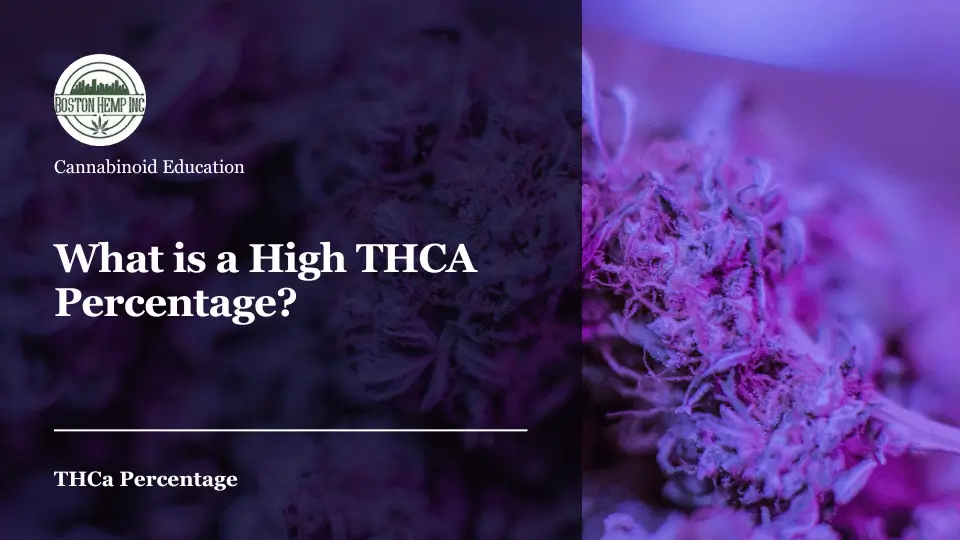
What is a High THCA Percentage?
When I step into the realm of cannabis culture, the talk often turns to the term high THC-A percentage.
This metric is pivotal for understanding the latent power of the cannabis plant, as it provides insight into future psychoactive effects once decarboxylation occurs.
But, it’s paramount to remember that THCA potency is not synonymous with a high immediately after consumption because, in its raw state, THC-a does not cause intoxication.
In my exploration of the topic, I’ve learned that THCA percentages exceeding the 25% mark are typically regarded as high for THCA flower.
On the other hand, THCA products that have percentages above 30% are considered high-percentage products.
Such numbers aren’t just digits—they act as beacons, guiding enthusiasts to a selection that promises a substantial therapeutic index or, post-decarboxylation, a markedly potent cannabis experience.
- High THCA content in flowers: Generally above 25%
- High THCA content in other products: Ranges from 30% +
A discerning eye toward the balance between a high THCA percentage and a personal threshold for effects is crucial.
While high THCA cultivars might not offer immediate euphoric sensations, the transformation that occurs when heat is applied turns the tables, leading to potent psychoactive effects.
Crafting a cannabis journey is about striking that harmony, ensuring that when you choose THCA-rich buds or products, you’re well-equipped for the experience that ensues post-conversion.
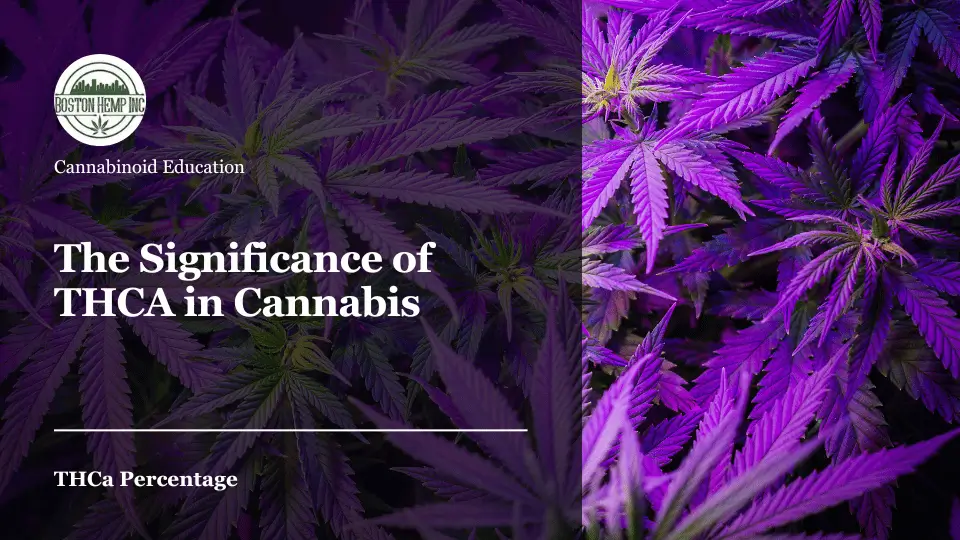
The Significance of THCA in Cannabis
As a keen observer of cannabis’s complex chemical makeup, I can’t help but emphasize the profound role of tetrahydrocannabinolic acid (THCA) in the plant’s repertoire.
This potent form of THCA holds keys to unlocking the plant’s full potential, and gaining a proper grasp on its characteristics is essential for anyone involved with cannabis, be it for medicinal or recreational purposes.
Defining THCA: The Non-Psychoactive Precursor
THCA stands as an intriguing component within the cannabis plant, taking the stage as a direct precursor to THC— the primary compound responsible for cannabis’s psychoactive effects.
However, it’s crucial to recognize that in its raw state, THC-A does not induce a high because it does not effectively bind to the cannabinoid receptors within our body.
This distinction paints THCA in a vastly different light than its famous counterpart, THC.
THCA’s Role in Cannabis Maturation and Decarboxylation
The journey of THCA from its nascent form to that of the psychoactive THC is a process steeped in the science of decarboxylation.
Whether through the slow transition over time or the quick application of heat, THCA sheds a molecular group to become the compound many enthusiasts seek.
This transformation is not only fascinating but pivotal in molding the experiences and benefits derived from cannabis.
Considerations for Therapeutic Use and Potential Side Effects
Finding balance is key when leveraging THCA for its therapeutic properties.
The myriad of promising effects, from anti-inflammatory to neuroprotective actions, make THCA a significant player in medical cannabis research.
Nonetheless, it is prudent to navigate its use thoughtfully, as overconsumption could usher in less desirable outcomes, including anxiety or discomfort.
| Attribute | THCA | THC |
|---|---|---|
| Psychoactive Effects | No | Yes |
| Binding to CB1/CB2 Receptors | Poorly | Effectively |
| Decarboxylation Requirement | Yes, for converting into THC | No, already activated |
| Legality | Varies, often legal | Varies, often tightly regulated |
Through my experiences and observations, I’ve learned that a genuine appreciation of THCA’s complexities allows us as a community to harness its benefits more effectively and responsibly, navigating its uses with a well-informed compass.
It’s not just a substance but a beacon for potential, guiding us to newer, more profound understandings of what cannabis has to offer.
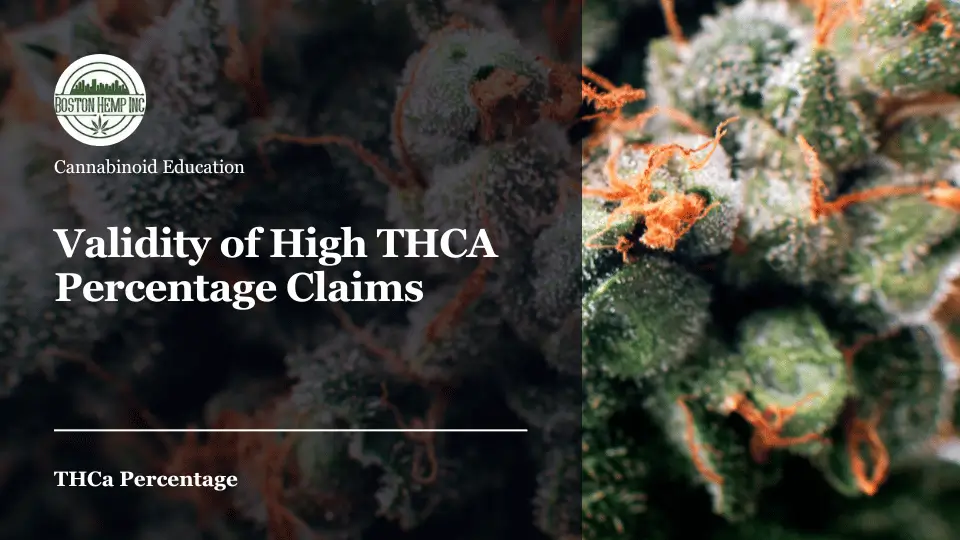
Validity of High THCA Percentage Claims
As I explore the intricacies of cannabis products, it’s become increasingly important to verify the accuracy of high THCA percentage claims.
Navigating cannabis labels to discern THCA vs THC and understanding the cannabinoid profile is essential not only for achieving the desired effects but also for ensuring legal compliance and accurate dosage.
Interpreting Cannabis Labels: THCA vs Other Cannabinoids
When scrutinizing a cannabis label, it’s the intricate details that make all the difference.
I take the time to compare the listed THCA percentage against other cannabinoids and gauge how this could influence the product’s effect once decarboxylated into THC.
This understanding is critical for both experienced users and newcomers to the scene.
Accuracy of Label Information and Cannabinoid Profiles
Trust but verify, they say, and with cannabis products, this adage holds true.
An accurate dosage is paramount, which is why I double-check the cannabinoid profiles promised on the packaging to ensure they align with my expectations and with the labs’ analyses that companies should provide.
Legality and Compliance with the 2018 Farm Bill
I always ensure the products I choose and offer comply with the 2018 Farm Bill.
Understanding the legal threshold of THC content helps in sidestepping any potential legal issues.
This means that even though a hemp-derived product might have a high THCA percentage, it’s the post-decarboxylation THC content that must remain within the legal limit.
| Cannabinoid | Label Claim | Lab Verified | Legal Limit |
|---|---|---|---|
| THCA | 27% | 27.2% | Delta-9 THC < 0.3% post-decarboxylation |
| CBD | 18% | 18.1% | |
| Delta-9 THC | 0.2% | 0.19% |
The table above provides a clear and thorough comparison, offering you the transparency you might require and expect.
It’s with this diligent approach to reviewing the claims and legal adherence that I can confidently enjoy the profound effects of cannabis, knowing that the high THCA content is not only genuine but also within the bounds of the law.

The Impact of Growing Conditions on THCA Levels
As someone who grows and deeply appreciates cannabis, I’ve learned that it’s the delicate balance between genetics and care that decides how much THCA ends up in a plant.
The plant’s genes lay the foundation, but it’s the unique mix of environmental factors each season that sharpens the strength of the strains we cherish.
Genetic Predisposition of Cannabis Strains
It’s no secret that certain cannabis genetics have the potential for higher THCA percentages.
I’ve seen firsthand how strains like ‘Ghost Train Haze’ and ‘Bruce Banner’ are genetically engineered to push the thresholds of cultivar potency.
By selecting the right genetics, growers can aim for a crop that naturally leans towards a more robust cannabinoid profile.
Environmental Factors and Harvest Time
Even with stellar genetics, environmental influence cannot be underestimated.
Variables such as light intensity, day-night temperature fluctuations, and even the composition of the soil can make or break a crop’s potential.
As I meticulously monitor these conditions, I seek the optimum harvest time—too early and the THCA is underdeveloped; too late and degradation may occur, converting it to THC.
Curing Process and Its Effect on Cannabinoid Content
The final brushstroke in cultivating cannabis with high THCA content is the curing process.
It’s a delicate balance to maintain the integrity of THC-A while also allowing for a full expression of the plant’s terpene profile, which contributes to the overall entourage effect.
A carefully controlled cure not only preserves potency but enhances the overall sensory experience.
In my pursuit of perfection within the bounds of my garden, I’ve found that aligning these key aspects is crucial for success.
I invite you to engage with the table below which encapsulates the harmony of factors influencing THCA levels:
| Factor | Influence on THCA | Cultivation Tips |
|---|---|---|
| Genetics | The genetic ceiling for THCA potential | Select high-THCA strains from reputable sources |
| Lighting | Photosynthesis & cannabinoid synthesis | Optimize light schedules and intensity |
| Temperature | Affects plant metabolism and growth | Maintain stable temperatures tailored to strain needs |
| Soil Health | Nutrient uptake and root health | Use quality soil and test pH regularly |
| Harvest Timing | Peak THCA levels and terpene profile | Harvest when trichomes are mostly cloudy with some amber |
| Curing | Stabilizes and preserves cannabinoids | Cure under controlled humidity and temperature |
My experience has taught me to regard each step as a vital component of a masterful cultivation practice.
Every season is an opportunity to refine these parameters further and, perhaps, achieve a new level of excellence in cultivar potency.

Determining Quality Through Potency Analysis
When we talk about cannabis quality, the conversation inevitably turns to the topic of potency.
For enthusiasts and patients alike, understanding the levels of THCA and Delta 9 THC in a product is crucial to ensuring its effects align with their expectations and needs.
Potency analysis serves as a critical tool by which consumers and industry professionals measure the strength and purity of cannabis products.
Understanding Potency: THCA vs. Delta 9 THC Concentration
The chemical profile of a cannabis product is dominated by its concentration of cannabinoids, notably THCA and Delta 9 THC.
THCA, in its natural state, is non-psychoactive and holds the potential for a variety of therapeutic benefits.
Once it undergoes decarboxylation, a scientific term for the application of heat or maturation, it converts into the psychoactive Delta 9 THC.
This is why products high in THCA potency are not immediately intoxicating but have the potential to become so.
Techniques for Converting THCA to THC
Mastering decarboxylation techniques is an essential skill for both producers and consumers.
The efficacy of converting THC-A into Delta 9 THC can be influenced by multiple factors, including the duration of heat application and the temperature used.
Whether through the direct flame of smoking, the controlled heat of vaporization, or the slow warmth of baking, understanding these methods is key to unlocking the full potential of THCA-rich products.
Comparing THCA Content Across Different Product Types
THCA thrives in many forms, from raw plant material to concentrated extracts.
Let’s consider how the THCA potency can differ significantly across various product types, and how this affects our choices as educated consumers:
| Product Type | Typical THCA Concentration | Considerations |
|---|---|---|
| Raw Flower | 15-30% | THCA content is reliant on strain and growing conditions. |
| Concentrates (e.g., Diamonds) | Up to 99% | High potential for psychoactivity post-decarboxylation. |
| Eatables (e.g., Gummies) | Varies | Often already decarboxylated for immediate effect. |
| Topicals | Minimal to None | Typically designed for therapeutic use without psychoactive effects. |
By becoming fluent in the language of potency analysis, I can navigate the market with confidence, selecting products that align with my preferences, whether seeking medicinal relief or pleasurable recreation.
This knowledge is not just power—it is the foundation of responsible and personalized cannabis use.

Converting THCA to THC: Processes and Outcomes
As a cannabis enthusiast, I’m always fascinated by the process of THCA conversion to the more commonly known psychoactive THC.
It’s not just a simple chemical reaction, but rather a critical transformation that unlocks the compound’s full potential.
When I think about THCA decarboxylation, I imagine the delicate dance of heat and time, working together to unmask the robust character of Delta-9 THC – something that I, along with so many others, appreciate for its psychoactive benefits.
The chemistry behind THCA activation is both intriguing and essential for me to understand.
It informs me about the potency of the product I’m using and helps me gauge the expected outcomes.
Knowing that only about 87 to 90% of THCA is transformed into Delta-9 THC, I’m always cognizant of this loss during decarboxylation.
It’s these fascinating details that guide me towards mindful consumption and a deeper appreciation for the processes behind the scenes.
| Method | Temperature | Duration | Conversion Rate |
|---|---|---|---|
| Sunlight Exposure | Variable | Several Weeks | Approx. 50-70% |
| Vaping | 157-227°C (315-440°F) | Instantaneous | Approx. 87-90% |
| Dabbing | 204-232°C (400-450°F) | Minutes | Approx. 87-90% |
| Oven Baking | 104-120°C (220-248°F) | 30-45 minutes | Approx. 85-90% |
My experience with different decarboxylation techniques has taught me that there’s a method to meet every preference and need.
Whether choosing to heat cannabis through cooking or simply enjoying the sun-drenched, naturally converted form, there’s a clear connection between method, temperature, and expected potency.
It’s this range of options that allows users like myself to tap into the benefits of psychoactive THC in the way we find most suitable.

Experiencing THCA: Consumption Methods and Effects
Embarking on a journey with THCA begins with understanding the various thca consumption methods available.
Whether you prefer the natural essence of raw cannabis flowers or the convenience of infused gummies, the way you consume THCA can greatly influence its effects on your body.
THCA Products: From Flowers to Gummies
Engaging with THCA doesn’t always have to lead to the ‘high’ commonly associated with cannabis.
By opting for products like raw flowers, juices, or gummies, you can experience the benefits of THCA without activating its psychoactive properties.
These options are ideal for those seeking the potential therapeutic thca effects without altering their cognitive state.
The Psychoactive Transformation: Decarboxylation Insights
However, for individuals looking to unlock the mood-altering benefits of THC, decarboxylation is a necessary step.
This heat-induced process facilitates cannabinoid activation, transforming THCA into the intoxicating THC.
Methods range from smoking and vaping to baking cannabis-infused treats, all of which offer different experiences and intensities.
Factors Influencing Your Experience with THCA
It’s pivotal to remember that your encounter with THCA is uniquely yours.
Your individual tolerance, metabolism, and the method you choose to consume all contribute to the impact THC-A will have.
While some may require minimal dosage, others may need higher quantities to feel the effects.
Always approach consumption with mindfulness and respect for your body’s responses.
- Raw cannabis consumption for non-psychoactive effects
- Decarboxylation methods like smoking for psychoactive experiences
- Understanding the decarboxylation effects on potency
- Emphasizing the importance of knowing individual tolerance levels

What Constitutes a ‘High’ THCA Percentage in Cannabis?
As a cannabis enthusiast, I’ve always been curious about what defines the ideal THCA percentage that promises maximum benefit without overwhelming the consumer.
The term ‘high’ can be quite subjective in the realm of cannabis, but when it comes to THCA, certain benchmarks give us a clearer picture.
Ideal and Maximal THCA Levels for Desired Effects
In my exploration, I’ve found that the optimal THCA levels vary depending on whether we are talking about flowers or extracts like diamonds.
For flowers, anything over 25% is considered significantly potent.
When dealing with concentrates, the numbers skyrocket with THCa diamonds saturated with a whopping 85% + THCA levels, which can be quite powerful.
How High Percentage Impacts Potency and User Experience
I’ve witnessed firsthand how a high THCA content can enhance therapeutics and, upon conversion to THC, elevate the psychoactive experience.
Yet, the catch is that high potency may not always translate to a better consumer experience.
More isn’t always more, as each individual’s response can be profoundly different.
Consumer Tolerance and the Virtue of Moderation
It’s not a race to the highest percentage but finding a personal sweet spot where therapeutic benefits are achieved without unwanted side effects.
Responsible use, built upon the virtue of moderation, helps to navigate the powerful waters of high-potency cannabis.
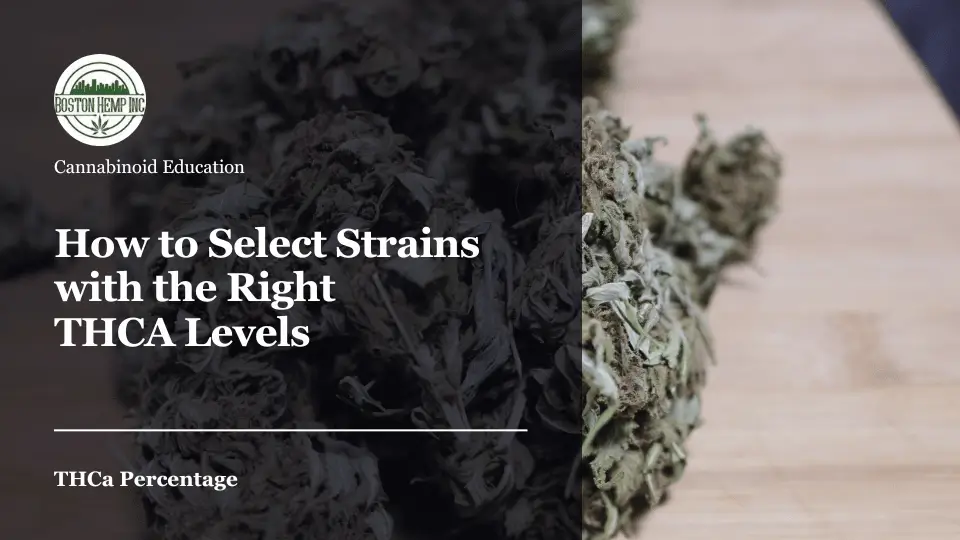
How to Select Strains with the Right THCA Levels
As I delve into the world of cannabis, understanding how to select the right strains to meet my consumption goals becomes paramount.
It’s all about finding that sweet spot where the levels of THCA align perfectly with what I’m looking to achieve, be it for therapeutic purposes or simply to enjoy the unique qualities of the plant.
Aligning THCA Content with Your Consumption Goals
When considering selecting THCA strains, I first reflect on my goals.
Do I need something to help with pain relief, or am I craving relaxation?
Perhaps I’m in pursuit of creative inspiration which will guide me towards a strain with a specific THCA concentration, optimizing my overall experience.
Evaluating Strain Quality and Predicting Effects
Accurate strain evaluation is key. I look into cannabinoid profiles, as they offer hints about the effects and potency I can expect.
With the knowledge gained over time, I can often predict how a certain level of THCA might influence my body and mind, leading to a more personalized and satisfactory outcome.
Seeking Professional Advice for Optimal Dosage
Navigating THCA concentrations isn’t just a hit-or-miss affair; I often seek professional dosage guidance when in doubt.
Cannabis experts can offer insights into how a particular strain’s THCA content will match my experience level and physiological responses, avoiding any unpleasant surprises.
| Strain | THCA Level | Potential Effects | Suggested Use |
|---|---|---|---|
| Ice Cream Cake Strain | 25% | Stress Relief, Mild Euphoria | Evening relaxation |
| Orange Pushpop Strain | 15% | Strong Pain Relief, Intense Relief | Medicinal, Controlled dosage |
| Sunset Mintz Strain | 17.5% | Focus, Creativity | Daytime use |
Remember, finding the ideal strain is a balance of art and science—taking into account my own consumption goals, utilizing comprehensive strain evaluation, and applying a bit of effect prediction.
With practice, patience, and perhaps guidance from seasoned professionals, I refine my ability to make informed choices in the expansive and ever-evolving cannabis landscape.

THCa Percentage FAQ
What is THCA and how does it differ from THC?
What is considered a high THCA percentage in cannabis products?
Can consuming high THCA flowers make you high?
How can I consume THCA safely?
Why is understanding THCA content important when selecting a cannabis product?
What factors influence the level of THCA in a cannabis plant?
How do I read cannabis labels to understand THCA content?
Are there different techniques to convert THCA into THC?
What does “potency analysis” refer to regarding cannabis?
Can higher levels of THCA lead to adverse effects?
How can I ensure I’m selecting strains with the right THCA levels for my needs?
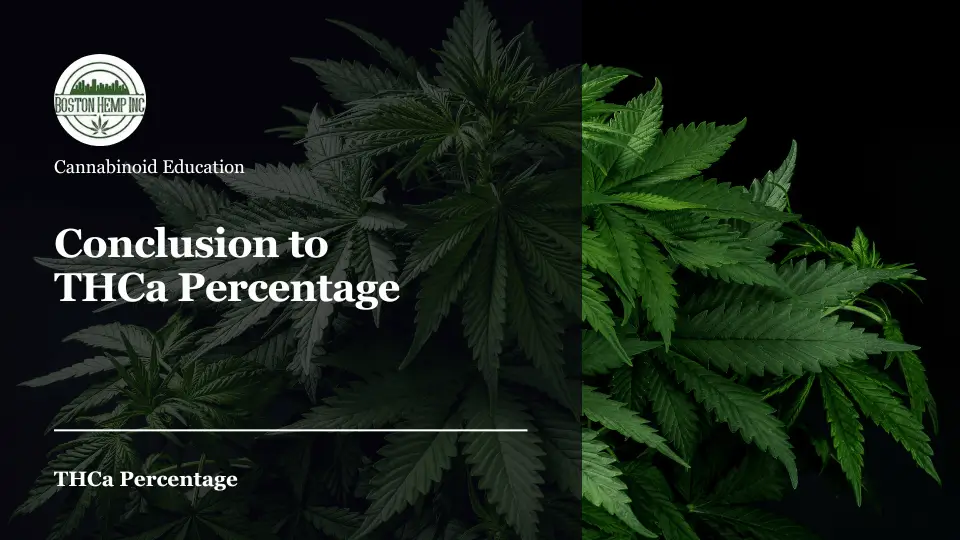
Conclusion to THCa Percentage
In my journey to comprehend the intricacies of cannabis, I’ve garnered substantial THCA knowledge, recognizing how high THCA percentages are pivotal to an informed cannabis choice.
It is not merely about the allure of potency but understanding the transformation and the eventual THC potentiation that comes with it.
This deeper insight allows me to make judicious decisions that resonate with my personal health objectives and consumption preferences.
By peeling back the layers and examining the differences between THCA and THC, and the myriad factors influencing their potency, I’ve learned how crucial it is to approach cannabis with high THCA percentage understanding.
Particularly important is how we leverage this understanding towards maximizing the THCA benefits while minimizing unwanted effects.
It’s fascinating to witness the variable impact of consumption methods on our experiences with the plant, which further amplifies the need for a well-rounded cognition of its properties.
Ultimately, my takeaway is clear: potency should serve as a guide rather than a solitary benchmark of quality or effect.
In tailoring cannabis to my personal needs, the principles of moderation and acknowledgment of my own tolerance have become cornerstone philosophies.
It’s this balance—between knowledge and mindful consumption—that ensures my encounters with cannabis are as enriching and beneficial as they can be.

